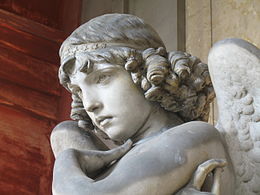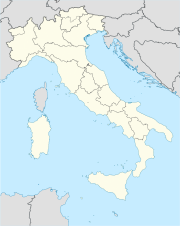Monumental Cemetery of Staglieno

The Oneto family monument, an angel by sculptor Giulio Monteverde
|
|
| Location of the Monumental Cemetery of Staglieno | |
| Details | |
|---|---|
| Established | 1851 |
| Location | Genoa |
| Country | Italy |
| Coordinates | 44°25′49″N 8°57′01″E / 44.430156°N 8.950327°ECoordinates: 44°25′49″N 8°57′01″E / 44.430156°N 8.950327°E |
| Type | Public |
| Size | 1 square kilometre (250 acres) |
The Cimitero monumentale di Staglieno is an extensive cemetery located on a hillside in the district of Staglieno of Genoa, Italy, famous for its monumental sculpture. Covering an area of more than a square kilometre, it is one of the largest cemeteries in Europe.
The design of the cemetery of the City of Genoa dates back to Napoleon's Edict of Saint-Cloud from 1804, when he forbade burials in churches and towns.
The original project was approved in 1835 by the City's architect Carlo Barabino (1768–1835). However, he died the same year as a result of the cholera epidemic that struck the city and the project passed to his assistant and pupil Giovanni Battista Resasco (1798–1871).
Part of the south-eastern hillside of Staglieno was acquired for the cemetery. The site of the Villa Vaccarezza was chosen as the most suitable, being both sparsely populated and close to the centre of the city. Work began in 1844 and it was opened on 2 January 1851. On that day there were four burials.
Over time there were several extensions and the cemetery now includes sections for an English cemetery, a Protestant one and a Jewish one. At the centre of the site is a tall statue of Faith, sculpted by Santo Varni. Facing the statue, up a grand staircase, is a domed Pantheon (a copy of the Pantheon in Rome) with a Doric portico flanked by two marble statues of the prophets Jeremiah and Job.
At the time Genoa was a major centre of learning within Italy and attracted reformists and an affluent bourgeoisie. Wishing to place long-lasting memorials to remember their work and moral accomplishments, they developed a tradition of funereal sculpture, particularly realistic works, to be placed with their tombs.
The cemetery contains the graves of Oscar Wilde's wife Constance Lloyd, Ferruccio Parri, Fabrizio De André, Nino Bixio, and Giuseppe Mazzini.
...
Wikipedia

